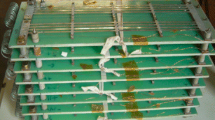Abstract
Superconducting fault-current limiters (SFCL) offer ideal performance in electrical power system. The design of SFCL has to be both flexible, to allow an easy adaptation to the specific requirements of each particular application, and a high quality standard with reproducible properties. Up to now no simulation model of SFCL has been validated or introduced in the Library of MATLAB software. In this paper a simulation model for a novel resistive type superconducting fault-current limiter is proposed. This model includes the electric field-current density (E–J) characteristics of High-Temperature Superconductors (HTS). A graphical interface using Graphical User Interface (GUI) of MATLAB is developed in order to ease the operation of the proposed model. This one facilitates the introduction or the parameter modification of materials candidate to a SFCL model. Thus, the operation characteristics and limitation behavior of SFCL have been investigated. The developed model accurately predicted the current-time waveforms achievable with typical limiters, and improved standard of understanding concerning the fault-current limitation mechanisms.













Similar content being viewed by others
References
Tixador, P.: Superconducting current limiters some comparisons and influential parameters. IEEE Trans. Appl. Supercond. 4(4), 190–198 (1994)
Leung, E.M.: Superconducting fault current limiters. IEEE Power Eng. Rev. 20(8), 15–30 (2000)
Lawrence, L.R. Jr., Cox, C.: High Temperature Superconductivity: The Products and Their Benefits. Bob Lawrence & Associates, Washington (2000)
Noudem, J.G., et al.: Study of the superconducting transition at high pulsed current of bulk Bi-2223 sintered and textured by hot forging. Physica C 281(4), 339–344 (1997)
Weller, R.A., et al.: Computer modelling of superconducting film type fault current limiters. IEEE Trans. Appl. Supercond. 9, 1377 (1999)
Dommerque, R., et al.: First commercial medium voltage superconducting fault-current limiters: production, test and installation. Supercond. Sci. Technol. 23, 034020 (2010)
Duron, J., Grilli, F., Dutoit, B.: Modelling the E(J) relation of high-T c superconductors in an arbitrary current range. Physica C 401, 231–235 (2007)
Yin, D., Schauer, W., Windte, V., Chen, J.: A new understanding of the resistive state and the V–I characteristic of high-T c superconductors. Z. Phys. B 94, 249–254 (1994)
Marsh, G.E., Wolsky, A.M.: AC losses in high-temperature superconductors and the importance of these losses to the future use of HTS in the power sector. Report submitted to International Energy Agency, USA, May 2000
Paul, W., et al.: Test of 1.2 MVA high-T c superconducting fault current limiter. Proc. Superconduct. Sci. Technol. 10, 914–918 (1997)
Author information
Authors and Affiliations
Corresponding author
Rights and permissions
About this article
Cite this article
Nemdili, S., Belkhiat, S. Modeling and Simulation of Resistive Superconducting Fault-Current Limiters. J Supercond Nov Magn 25, 2351–2356 (2012). https://doi.org/10.1007/s10948-012-1685-z
Received:
Accepted:
Published:
Issue Date:
DOI: https://doi.org/10.1007/s10948-012-1685-z




